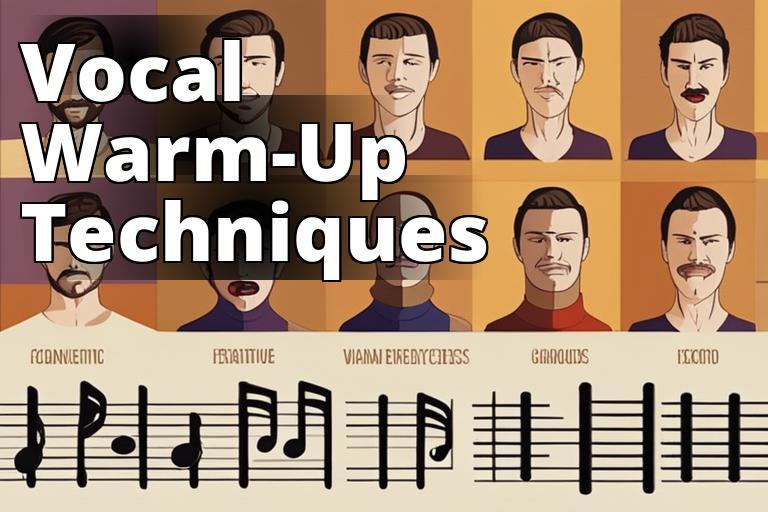Every singer knows that a great performance starts long before stepping onto the stage. It begins with a series of vocal exercises that prime the vocal cords for the demands of singing. Just like athletes stretch before a game, singers must use a specific phrase or set of phrases to warm up vocals to ensure their voice is agile, clear, and ready for the show. Warming up your voice can prevent strain and injury while improving your range and tone. In this comprehensive guide, we’ll walk you through 10 vocal exercises that are key to a successful vocal warm-up.

Vocal Warm Up Techniques
Learn 10 vocal warm-up techniques for singers.
– Lip trills, tongue trills, humming, sirens, scales, octave jumps, vowels, consonants, descending scales, and descending octave jumps are effective warm-up exercises for singers.
– These vocal warm-ups help to improve vocal flexibility, tone, and control, and prepare the voice for singing.
H1. 10 Vocal Warm Ups for Singers
When it comes to vocal warm-ups, variety is crucial. Each of these exercises targets different aspects of your voice, from breath control to pitch accuracy. By incorporating a mix of these techniques into your routine, you can achieve a well-rounded warm-up that sets the stage for vocal brilliance.
1. Lip Trills
Lip trills are a staple in many vocal warm-up routines. They involve blowing air through closed lips, creating a brrr-like sound. This exercise helps regulate breath control and relieve tension in the lips and face, which is essential for articulation.
Insider Tip: Focus on keeping the airflow steady and consistent to get the most out of this exercise.
2. Tongue Trills
Tongue trills, similar to lip trills, involve rolling the ‘R’ sound. This exercise targets the flexibility and strength of the tongue, which is vital for clear pronunciation and fast vocal runs.
Insider Tip: If you struggle with tongue trills, try placing the tip of your tongue behind your upper teeth to stabilize it.
3. Humming
Humming warms up the voice gently by resonating sound through the nasal passages and creating a smooth, even tone. It can be done on various pitches and scales and is excellent for connecting breath support with vocalization.
Insider Tip: Humming with lips slightly apart and teeth not touching can create more resonance and a freer sound.
4. Sirens
The siren exercise involves sliding from the lowest note you can sing to the highest and back down. It’s a fantastic way to stretch the vocal cords and work through your entire range.
Insider Tip: Visualize your voice as an actual siren moving smoothly over the peaks and valleys of your range to avoid abrupt breaks or shifts.
5. Scales
Singing scales is a fundamental exercise for improving pitch accuracy and agility. Start with simple major scales and progress to more complex patterns like chromatic or pentatonic scales.
Insider Tip: Use a piano or a tuning app to ensure you’re hitting each note correctly.
6. Octave Jumps
Octave jumps involve singing a note and then jumping to the same note one octave higher or lower. This exercise helps develop vocal control and strength, especially across large intervals.
Insider Tip: Start slowly and increase your speed as your voice becomes more agile.
7. Vowels
Singing through the vowels (A, E, I, O, U) helps work on enunciation and tone quality. Each vowel has a different placement and feeling in the mouth and throat, so this exercise can also help with vocal flexibility.
Insider Tip: Pay attention to the shape of your mouth and the space in your throat as you transition between vowels.
8. Consonants
Practicing consonants, especially the more challenging ones like ‘S,’ ‘R,’ and ‘L,’ can help improve articulation. Singing phrases that emphasize these consonants can make the words clearer when you perform.
Insider Tip: Consonant exercises can also be a fun way to work on diction with tongue twisters.
9. Descending Scales
Descending scales are just as important as ascending ones. They help you work on releasing notes and maintaining vocal control as you move to lower pitches.
Insider Tip: Focus on maintaining support from your diaphragm rather than letting the voice “fall” as you descend.
10. Descending Octave Jumps
Similar to ascending octave jumps, descending octave jumps challenge you to maintain pitch and tone quality while moving downward in your range. It’s an excellent way to ensure vocal stability.
Insider Tip: Visualize landing gently on each note to avoid a harsh or heavy sound.
How to Warm Up Your Voice: ## Real-Life Vocal Warm-Up Experience
I remember when I first started taking singing lessons, I struggled with finding the right vocal warm-up routine. My instructor, Sarah, suggested starting with lip trills to ease into the warm-up process. She explained how lip trills help in relaxing the vocal cords and getting the breath flowing properly.
After incorporating lip trills into my warm-up routine, I noticed a significant improvement in my vocal control and overall performance. It not only helped with my singing but also made it easier to transition into other warm-up exercises like scales and octave jumps.
Sarah’s guidance and the effectiveness of lip trills really emphasized the importance of a proper vocal warm-up routine for me. It set the foundation for a successful practice and performance, showing me the real impact of starting with the right warm-up exercises.
Final Thoughts
Warming up your voice is a critical component of vocal health and performance quality. By incorporating these 10 exercises into your routine, you can help ensure your voice remains in top condition. Remember, vocal warm-ups should be done regularly, not just before a performance. Consistency is key to developing a reliable and resilient voice.
As you continue to explore the world of singing, consider diving deeper into techniques specific to various genres. Whether you’re interested in the precision of classical singing, the power of rock vocals, or the nuanced delivery of jazz, there’s a world of vocal techniques to explore. Check out our resources for K-pop singers, basic techniques, and insights into the vocal styles of Asian singers, including Korean, Filipino, Chinese, and Japanese female singers.

Your voice is your instrument, and like any valuable instrument, it deserves to be taken care of with the best possible practices. Invest time in your vocal warm-ups, and your voice will surely return the favor when it’s time to perform. Happy singing!

FAQ
Who can benefit from using a phrase to warm up vocals?
Singers, public speakers, and actors can benefit from vocal warm-up phrases.
What is the purpose of using a phrase to warm up vocals?
Using a phrase helps to relax the vocal cords and improve vocal range.
How can I incorporate a phrase to warm up my vocals?
Start with simple vowel sounds and gradually move to more complex phrases.
What if I don’t have time to warm up my vocals with a phrase?
Even a few minutes of vocal warm-up with a phrase can make a difference.
How long should I warm up my vocals with a phrase?
Aim for at least 10-15 minutes of vocal warm-up with a phrase.
What if I feel self-conscious using a warm-up phrase?
Remember, vocal warm-ups are essential for a strong performance.



